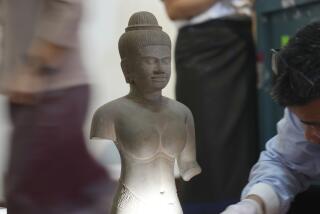King Tut’s artifacts may return to LACMA
The fabled treasures of King Tut may return to the United States next June, the first time they have appeared in the United States since their widely heralded visit in 1978, according to Egyptian officials.
The details of the tour have not been confirmed, but the exhibit would visit Los Angeles, Chicago and two other cities that have not been chosen, said Zahi Hawass, president of Egypt’s Supreme Council of Antiquities.
Hawass said he would like for the tour of the treasures to begin at the Los Angeles County Museum of Art. Nancy Thomas, deputy director of the museum, said LACMA was very interested but had yet to receive a formal proposal. “We would love to host it if possible,” she added.
The exhibit was a huge success when it previously visited the United States, with people lining up to get into museums. LACMA sold 661,000 advance tickets for its 16-week run.
Museum officials said it should be equally successful this time around, albeit with a slightly different group of artifacts.
Tutankhamen’s tomb was found nearly intact in 1922 in Egypt’s Valley of the Kings, near Luxor, by archeologist Howard Carter. The discovery is considered one of the greatest archeological finds of the century because of the magnificence of the artifacts.
Tut, who was most likely a son of the Pharaoh Akhenaten, died in 1323 BC at age 18.
A collection of 50 items from Tut’s tomb along with 70 other artifacts from the Valley of the Kings is on display at the Basel Museum of Ancient Art in Switzerland, the first time the artifacts have been out of Egypt in 20 years.
Among the items in the show is a miniature gold burial casket, inlaid with precious stones. Another is an alabaster portrait of the king that was originally the stopper from a canopic jar.
Also included are artifacts from the tomb of Yuya and Tuyu, parents of the wife of Amenhotep III. That tomb was discovered about 20 years before Tut’s and was considered the greatest find until Carter’s was revealed.
Officials expect more than half a million people to visit the Basel exhibit before it closes in October.
The exhibit would then visit a European city before coming to the United States, perhaps after being reconfigured slightly, Thomas said.
The tour of the artifacts is being organized to raise funds for the construction of the planned Grand Museum in Cairo, a $350-million edifice to be constructed near the pyramids. The museum, scheduled to be completed by 2007, will house many of the works from Cairo’s Egyptian Museum, which was built in 1900. It has inadequate display space and poor visitor facilities.
The 3,500 pieces from Tutankhamen’s tomb, of which only 1,700 are on display, will be the centerpiece of the new museum. It is only fitting that the artifacts should help raise funds for it, Hawass said.
“King Tut is building the new museum,” he said.


